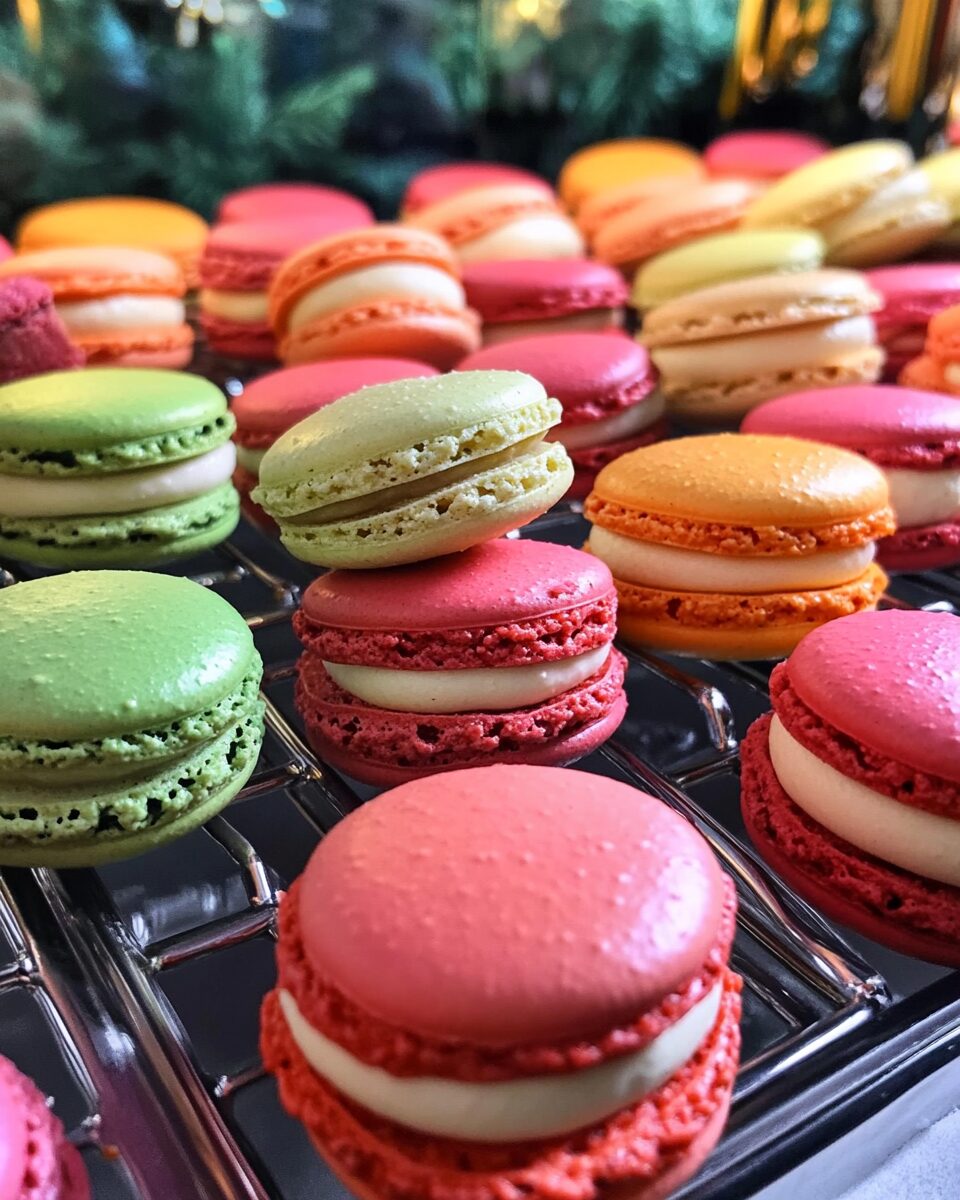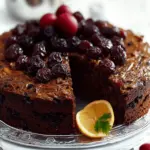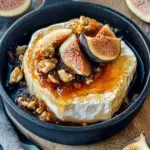The delicate crunch of a perfectly baked macaron shell gives way to a rich and creamy filling that melts in your mouth. These delightful treats are the epitome of French patisserie charm—refined, colorful, and utterly addictive.
While they may have a reputation for being tricky to master, this recipe simplifies the process with clear steps and pro tips. Whether you fill them with ganache, jam, or buttercream, macarons bring a touch of Parisian elegance to your home kitchen. Ideal for gifting, celebrations, or an indulgent afternoon tea, they’re as fun to make as they are to eat.
Full recipe:
Ingredients:
-
4 extra large egg whites
-
1 ⅔ cups confectioners’ sugar
-
1 ⅓ cups almond flour
-
⅛ teaspoon salt
-
¼ cup superfine (castor) sugar
-
Chocolate ganache, seedless jam, or buttercream for filling
Directions:
-
Place egg whites into a metal mixing bowl and refrigerate overnight. The next day, bring egg whites to room temperature.
-
Preheat the oven to 280°F (138°C). Line two baking sheets with parchment paper.
-
In a separate bowl, whisk together confectioners’ sugar and almond flour until evenly combined.
-
Beat egg whites with salt using an electric mixer on medium speed until foamy, about 1 minute.
-
Gradually add superfine sugar, one tablespoon at a time, while increasing mixer speed to high. Beat until stiff, glossy peaks form (about 3-5 minutes).
-
Gently fold the almond flour mixture into the whipped egg whites until smooth and fully incorporated.
-
Transfer mixture to a piping bag fitted with a 3/8-inch round tip. Pipe 1-inch rounds onto the baking sheets, spacing them about 2 inches apart.
-
Tap the baking sheets against the counter to release air bubbles. Let sit at room temperature for 25–30 minutes, until the tops lose their shine and a skin forms.
-
Bake in the preheated oven for 19–20 minutes, until the tops are dry and set.
-
Allow to cool completely on baking sheets before peeling them off the parchment.
-
Pair up cookies by size. Fill one side with your choice of chocolate ganache, jam, or buttercream. Sandwich with another cookie.
-
Refrigerate for at least 2 hours, or overnight, to allow macarons to soften and flavors to meld.
Prep Time: 10 hours (includes aging of egg whites)
Cooking Time: 20 minutes
Total Time: 11 hours 30 minutes
Kcal: 73 kcal
Servings: 15
A Brief History of Macarons
The macaron’s history dates back to the 8th century, where it is believed to have originated in Italian monasteries. The word “macaron” is derived from the Italian word maccherone, meaning fine dough. It wasn’t until the Renaissance period that these almond meringue cookies found their way to France, brought over by Catherine de’ Medici’s Italian pastry chefs when she married Henry II of France.
However, the version of macarons we know today—with two delicate cookies sandwiching a filling—is attributed to the French capital. Pierre Desfontaines of the Ladurée pastry house in Paris is credited with creating the double-decker macaron in the early 20th century. Since then, macarons have become a signature Parisian sweet and are now enjoyed around the world.
Understanding the Structure of a Macaron
Each macaron is composed of two parts: the shell and the filling. The shell is made primarily of egg whites, confectioners’ sugar, almond flour, and superfine sugar. This unique combination results in the macaron’s iconic texture—crisp on the outside, yet slightly chewy inside.
The batter consistency and folding process (known as macaronage) are essential. Overmixing can result in flat, cracked cookies, while undermixing causes lumpy and uneven surfaces. Once piped, macarons must rest to develop a “skin” on the surface, which contributes to the formation of the ruffled edges known as the “feet.”
Fillings can be anything from classic chocolate ganache and vanilla buttercream to passionfruit curd or raspberry jam. Not only do fillings provide flavor and moisture, but they also help balance the sweetness of the meringue-based shells.
Why Macarons Are Considered Tricky to Make
Even professional bakers will admit: macarons are notoriously temperamental. Small factors like humidity, improper folding technique, oven hotspots, or even overly fresh egg whites can sabotage a batch. That’s why aged egg whites are often recommended—they whip better and create a more stable meringue.
Timing is critical too. The resting phase allows the macarons to form a skin that prevents cracking and promotes uniform rising in the oven. Skipping this can result in misshapen cookies without feet. Furthermore, baking time and temperature must be precise. Too hot, and the shells brown; too cool, and they won’t rise properly.
The learning curve may be steep, but the satisfaction of achieving the perfect macaron is unparalleled. It’s a process that sharpens baking skills and rewards persistence.
Flavor and Color Customization
One of the most exciting aspects of making macarons is the endless possibility for customization. While traditional flavors like vanilla, chocolate, and pistachio remain favorites, adventurous bakers have expanded the flavor spectrum to include matcha, earl grey, lavender, salted caramel, lemon basil, and more.
Food coloring gels are commonly used to tint the shells in vibrant hues, matching the flavor profile or fitting a special occasion. From pastels for baby showers to bold reds and greens for holiday gatherings, macarons are a visual treat as much as they are a culinary one.
Fillings are equally versatile. A smooth ganache brings richness, buttercream offers creaminess and flexibility, and jams bring tart balance. Infusing the fillings with liqueurs, fruit zests, spices, or nut butters elevates the flavor complexity even further.
The Macaron’s Role in Celebrations and Culture
Macarons have become synonymous with celebration. Whether served at weddings, baby showers, bridal teas, birthdays, or holiday gatherings, their sophistication and visual appeal make them a standout addition to dessert tables. Their ability to be customized makes them perfect for color-themed events or personalized gifting.
In some cultures, macarons symbolize elegance and refinement. In Japan and South Korea, they’re often gifted as premium sweets, sometimes even forming part of luxury gift boxes. In Western countries, they’ve grown beyond French patisseries and now appear in coffee shops, supermarkets, and even DIY baking kits.
Macarons are also a favorite for social media, especially platforms like Instagram and Pinterest. Their aesthetic charm and the wide variety of colors and flavors make them a viral subject for bakers, influencers, and foodies alike.
Tips for Success with Homemade Macarons
To succeed with homemade macarons, it’s important to be patient and follow a few essential tips:
-
Use aged egg whites: Letting egg whites sit in the fridge overnight helps reduce moisture and improves whip stability.
-
Measure by weight: Macarons require precision, and using a digital scale is far more accurate than volume measurements.
-
Sift the dry ingredients: Almond flour and confectioners’ sugar can clump, and a smooth batter depends on finely sifted ingredients.
-
Use a template when piping: A guide ensures uniform size, which is important for pairing cookies evenly.
-
Rest the shells: Do not skip this step—wait until the shells are dry to the touch before baking.
-
Test your oven: Use an oven thermometer to avoid temperature inconsistencies.
-
Be creative, but cautious: Don’t add liquid extracts to the batter itself—this can alter consistency. Add flavors to fillings instead.
Macarons vs. Macaroons—Don’t Confuse Them
A common mistake is confusing macarons with macaroons. While their names sound similar, they are completely different cookies. Macarons, as described, are delicate almond meringue sandwich cookies. Macaroons, on the other hand, are dense, chewy cookies made with shredded coconut and are often dipped in chocolate. They’re easier to make and require no meringue.
This distinction is important for those looking to explore French baking versus simpler American-style treats.
Storage and Shelf Life
One of the best features of macarons is their longevity when stored properly. After assembly, they should be stored in an airtight container in the fridge for at least 24 hours before eating. This rest period allows the flavors to meld and the shells to soften slightly from the filling—a process called “maturing.”
Properly stored, macarons can last 4 to 5 days in the fridge. They can also be frozen, both filled and unfilled, for up to a month. This makes them a great make-ahead dessert for parties or gifting.
Conclusion: Why You Should Master Macarons
French macarons are the gold standard of refined baking. They test your technique, your patience, and your ability to follow precision. But they reward you with a dessert that is equal parts art and indulgence. While they may take time to perfect, the results are well worth the effort—both in flavor and presentation.
Mastering macarons opens up a world of creative possibilities in your kitchen. From experimenting with flavors and colors to creating custom fillings, you’ll find endless inspiration in these delicate confections. Whether you’re baking for a special event, for a loved one, or simply to challenge yourself, French macarons are a beautiful, tasty way to elevate your baking journey.






